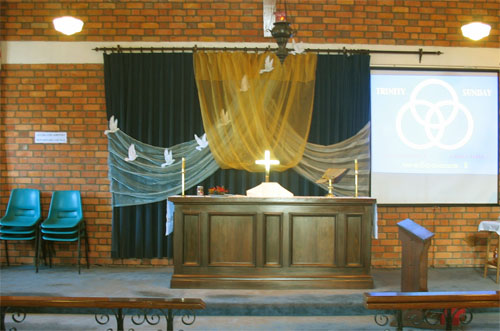|
| BEFORE THE SERVICE -
|
|
Furniture :
|
- Kneeling desk half-facing congregation in front of altar bottom step towards organ side;
- Light chairs ready to put in front of altar.
|
|
Properties :
|
- On blue curtain : symbol for the Trinity;
- Sign on the wall :
| AUCKLAND AIRPORT
DEPARTURE LOUNGE |
- "Burning coals" of fire and tongs on altar.
- Adoption papers;
- Cabin travel bags at the back for the travellers;
- a Bible in Beth's cabin baggage;
- Wheelchair at the back, with bag hanging on its back, and hair brush in the bag.
|
|
People :
|
- Minister at lectern,
- Computer person at computer,
- Organist at organ,
- People to hand out orders of service and liturgy books at beginning of service
|
|
What it looked like :
( Click the picture for a jpg file; notice that the jelly beans and burning coals are on the altar at the left-hand end. )
| 
|
|
|
ADOPTION PAPERS
| Something plausibly like a somewhat impressive legal document. ( In fact, we used a real adoption paper, which was not impressive at all. )
|
|
BURNING COALS
| A flat dish on the altar contains a number ( five or six is sufficient ) of "burning coals" as described here.
|
|
CHERUBIM
| The number of cherubim is arbitrary; only the Head cherub speaks.
|
|
COOL
| meant "good" when we presented the service.
|
|
FLYING
| We have a stock of costumes for angel-like characters, with "wings" which attach to their arms. "Flying" means trotting or running while waving the arms. We don't even try to manage six wings each.
|
|
FRIENDS
| The script is written for four friends, but the number isn't critical. ( We expanded it from three just before the service was presented. ) Juggle the speaking parts to fit the number available.
|
|
HOLY COMMUNION
| We used a somewhat shortened form of our customary service of Holy Communion from the New Zealand Prayer Book. As this is subject to copyright restrictions, we cannot include it here.
|
|
IN A LINE
| The detailed geography is not particularly important, and will depend on the space available. The important constraint is that Beth must be able to sit in a position where she can easily see the old man in the wheelchair when he's parked in place. There should be enough seats and other actors to give the impression of a very public performance.
|
|
KNEELING DESK
| Placed half-facing the congregation in front of the altar, on the bottom step towards the organ side. ( Just to the right of the altar in the picture. )
|
|
LIGHT CHAIRS
| Chairs for the "departure lounge", stacked ( preferably inconspicuously ) ready to be moved into position when required.
|
|
NEAREST THE LECTERN
|
More generally, a seat from which Beth can clearly see the old man but has to get up and walk past other people to reach him.
|
|
ONE OF THESE STORIES
|
In the "Encourager" issue 122, March 2009 : available ( 1.4MB pdf file ) here.
|
|
POEM
| An original composition, written for this service.
|
|
PUBLIC ADDRESS SYSTEM
| Something that sounds like the sort of public address system found in airports. It's intended to be a joke, so needn't sound particularly authentic provided that it's close enough to be recognisable.
We used someone with a loud voice, speaking loudly from our balcony ( out of sight ) through cupped hands with his nose blocked. It worked.
Notice that some of the "announcements" have a strongly local flavour; replace them with your own.
The three announcements listed together should be spaced out throughout the time taken to set the scene.
|
|
SYMBOL FOR THE TRINITY
| This was the three swathes of gauzy fabric seen behind the altar in the photograph above. It was not really mentioned in the service, and perhaps more could have been made of it. ( The more familiar symbol of three circles is also visible, but that's on the projector screen; that was mentioned in the sermon. )
|
|
TRAVELLERS
| Several. The number isn't critical, but too few looks a bit cheap and too many clogs up the acting area and requires more chair shifting. We had about eight, which seemed to work well.
|
|
VERY LOUDLY
|
Means just what it says. The old man is deaf; a significant point of the story is the very public nature of the conversation.
|
